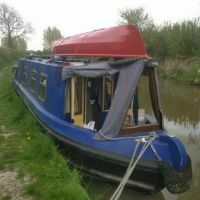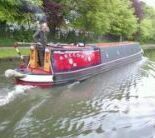After 30 + years of narrowboating I finally cracked this problem during the final couple of years.. Mooring pins in the towpath are not good as they can damage the structure of the bank and can be a danger to walkers at night.. As the use of steel pilling is now close to universal some form of mooring to them is the obvious way to go, hooks can be OK but they are a bit vulnerable to being kicked off by vandals, simply falling off as mooring lines slacken, or just pinched.. Anyway I have never quite trusted them..
That leaves Goat Chains, I managed to keep the same pair for 20 years but deploying them when the grass was wet or in a doggy walkies area is not pleasant..
I devised a method which not only dispensed with the need to kneel on the ground but it does not even require bending down, it needs no more than a '2 ft stick with a hook on the end', I acquired a particularly short window pole some time ago.
Dangle one end of the chain behind the horizontal element of the pilling* using one hand, with the other, hook the hanging ring of the chain and pull it upward so the two rings are together.. "I have always favoured the use of old climbing rope for mooring lines", so create a loop in the line and push it through both rings and then take it back to your bollard or 'T' stud and pass it over.. Tie off in the usual way but note that you now have 4 lines, boat to bank..
*Sometimes to prevent jambing of the chain it is better to select a gap in the pilling that has a tie-rod passing through it..
Goat Chain:- 3-4 feet length of open linked chain, each end fitted with a ring 2-3 inch dia. ring fabricated from typ. 6mm dia m/s round bar.
Reading this you will say, Hmm bloody obvious I knew that.. But try it, it will change your life..







